Tailieumoi.vn xin giới thiệu bài tập Tiếng Anh lớp 11 Unit 6: Preserving our heritage sách Global Success có đáp án, lời giải chi tiết, chọn lọc. Hi vọng với bộ tài liệu Tiếng Anh 11 có đáp án này sẽ giúp bạn ôn luyện kiến thức để đạt kết quả cao trong bài thi môn Tiếng Anh 11 sắp tới.
Bài tập Tiếng Anh 11 Unit 6: Preserving our heritage
A. Pronunciation
• Intonation in statements, commands, and lists
Mark the intonation in the following sentences, using (falling intonation) or (level-rising intonation). Then practise saying them in pairs.
1. We should make clubs more interesting for teenagers.
2. It is important to raise people’s awareness of its importance.
3. Forms of cultural heritage include folk music, singing, and dancing.
4. We can go on a tour by boat, see areas of natural beauty, and listen to folk music.
5. All buildings are kept in their original state.
6. Young people can contribute more to heritage preservation.
7. We can see its natural beauty with beautiful limestone mountains, valleys, and rivers.
8. She enjoys reading novels set in the 19th century.
9. Cultural heritage may include temples, pagodas, and monuments.
10. The most UNESCO World Heritage Sites in Viet Nam are Hoi An, Phong Nha Cave, Thang Long Citadel, Hue Citadel and Ha Long Bay.
B. Vocabulary
• Words and phrases related to preserving heritage
I. Complete the sentences with the words given.
|
folk |
historic |
complex |
historical |
preserve |
|
architecture |
cultural heritage |
restored |
folk music |
landscape |
1. The art students were told to sketch the __________________.
2. He drew his inspiration from traditional Vietnamese __________________.
3. We want to __________________ the character of the town while improving the facilities.
4. The town’s modern __________________ is very well integrated with the old.
5. The badly neglected paintings have all been carefully __________________.
6. Modernizing __________________ buildings can often do more harm than good.
7. Many important __________________ documents were destroyed when the library was bombed.
8. We visited an exhibition of __________________ art.
9. Some old buildings were pulled down to make space for a new shopping __________________.
10. These monuments are a vital part of the __________________ of South America.
II. Match each description with the words below.
|
archaeology |
permission |
interpretation |
|
admiration |
preservation |
civilization |
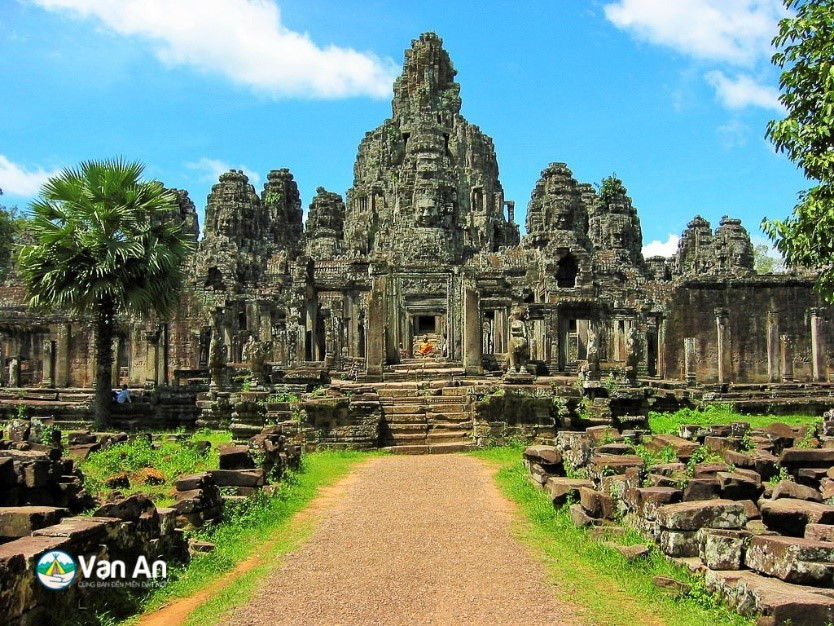
Angkor Wat
Cambodia’s Angkor Wat National Museum collects and protects artifacts from the nearby Angkor Wat temple complex. 1 __________________
The architects and builders who created Angkor Wat in Cambodia did amazing work. It impresses everyone who sees it. 2 __________________
Archaeologists digging at Angkor Wat recently discovered a large statue buried beneath the ground.3 __________________
Angkor was the capital city of the Khmer Empire, which ruled the area from the 9th to the 15th centuries. 4 __________________
The museum gives a lot of explanation about the history of Angkor Wat and the people who built it. 5 __________________
Sometimes, parts of Angkor Wat are closed to the public, and only workers are allowed to enter them. 6 __________________
III. Fill in each blank in the passage with the correct word / phrase below.
|
temples |
community |
designs |
merchant |
pillars |
|
merchant ships |
attractions |
trading port |
destination |
objects |
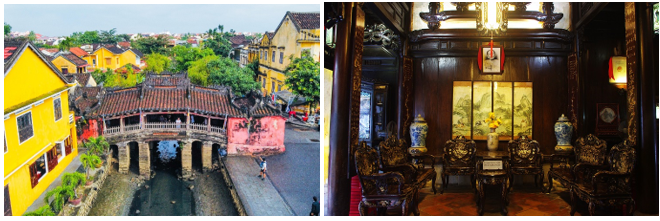
The ancient town of Hoi An lies on the Thu Bon River, 30 km south of Da Nang. It was formerly a major 1 __________________ in Southeast Asia between the 16th and the 17th centuries. Hoi An was also an important centre for Dutch, Portuguese, Italian, Chinese, Japanese and other 2 __________________ from the Far East.
Hoi An is famous for its old 3 __________________, pagodas, ancient homes and narrow streets. All the houses were made of wood and their 4 __________________were carved with ornamentaln5 __________________.
One of the main 6 __________________ of Hoi An is the Japanese Bridge, which was built in the 16th century and is still well-preserved. All visitors to Hoi An are recommended a visit to the Assembly Hall of Cantonese Chinese Congregation. This house was built in 1855 and still keeps many precious 7 __________________ that belonged to the Chinese 8 __________________ of Hoi An. Another attractive address to tourists is Tan Ky House, which was constructed nearly two centuries ago as a house for a Vietnamese 9 __________________. The house now looks almost exactly as it did in the early 19lh century.
In recent years, Hoi An has become a popular tourist 10 __________________ in Viet Nam. In 1999, it was certified by UNESCO as a World Cultural Heritage Site.
IV. Complete the following sentences with the correct form of the words in brackets.
1. In 1805, King Gia Long requested the building of a new, smaller citadel called Ha Noi Citadel with a new __________________ style. (architecture)
2. The Complex of Hue Monuments is a __________________ of many royal monuments from the Nguyen Dynasty. (combine)
3. As for me, the Citadel of the Ho Dynasty is one of the most __________________ destinations in Viet Nam because of its value. (attract)
4. Homestay has become __________________ when historic travel is on the rise. (trend)
5. __________________ of Cultural Heritage is an international degree programme at University of Bologna in Italy. (restore)
6. Cat Ba Archipelago bears the exceptionally natural values with its __________________ forests which cover the limestone system and the mangrove wetlands. (tropic)
7. Besides the __________________ value of geology, Phong Nha - Ke Bang is also favoured with the mysterious and majestic landscapes by nature. (history)
8. Management and __________________ in Hoi An are further strengthened through master planning and action plans. (preserve)
Prepositions
V. Complete each sentence with the correct preposition.
1. The report offers suggestions __________________ improvement __________________ policy.
2. The building is __________________ a bad state of repair.
3. Businessmen can get opportunities to reach the public __________________ social media such as blogs, podcasts and other forms.
4 Participants are encouraged to give voice __________________ their personal hopes, fears and dreams.
5. It was a real team effort — everyone contributed something __________________ the success of the project.
6. Children can have fun and learn __________________ music at the same time.
7. He already had an idea __________________ his next novel.
8. She trained __________________ the race, sometimes running as much as 60 miles a week.
9. We need to explain why these issues are important and relate them __________________ everyday life.
10. The meeting was a social event __________________ retired people in the neighbourhood.
C. Grammar
• To-infinitive clauses
I. Combine the first halves to the second ones to make meaningful sentences with to-inflnitive phrases.
1. I went to the garden centre
2. When the teacher asked him a question, Jack pretended
5. My mother always said I should eat lots of green vegetables
7. Before I visit Japan next summer, I really want
8. It’s a good idea
9. Mai has to practise at least four hours every day
10. Jim finally went to the dentist
______ A. to let some fresh air in.
______ B. to stay healthy.
______ C. to understand what she was saying.
______ D. to know where your children are at all times.
______ E. to get some relief from his toothache.
______ F. to get some fertilizers for my flowers.
______ G. to repair my bike.
______ H. to change a light bulb on the ceiling.
______ I. to learn some useful Japanese phrases.
______ J. to be ready for her piano competition next month.
II. Combine the suitable sentences in each group to form new meaningful ones using to-infinitive phrases.
1. I shouted. ______ A. I want to keep warm.
2. I had to go to the bank. ______ B. I want to report that my bike had been stolen.
3. I’m saving money. ______ C. I want to go to Singapore.
4. I went into hospital. ______ D. I had to have an operation.
5. I’m wearing two pullovers. ______ E. I needed to get some money.
6. I phoned the police station. ______ F. I want to warn people of the danger.
1. I shouted to _______________________________________________________________________.
2. _________________________________________________________________________________.
3. _________________________________________________________________________________.
4. _________________________________________________________________________________.
5. _________________________________________________________________________________.
6. _________________________________________________________________________________.
III. Complete the sentences using a suitable verb.
1. I didn’t have enough time ________________ the newspaper today.
2. He came home by taxi. He didn’t have enough energy ________________ home.
3. ‘Would you like something ________________?’ - ‘Yes, please. A cup of coffee.’
4. We need a bag ________________ these things in.
5. There will be a meeting next week ________________ the problem.
6. I wish I had enough money ________________ a new bike.
7. I saw Hoa at the party but we didn’t have a chance ________________ to each other.
8. I need some new clothes. I haven’t got anything nice ________________.
9. They’ve just passed their exams. They’re having a party ________________.
10. I can’t do all this work alone. I need someone ________________ me.
IV. Rewrite the answers in the short exchanges using to-infinitive phrases.
Example:
Why did you come here?
- Because I wanted to see my friends.
I came here to see my friends.
1. Q: Why do you go to the beach every weekend?
A: Because I like swimming.
She
2. Q: Why did you move to Ha Noi?
A: I wanted to find work.
He
3. Q: Why are you leaving home?
A: I’m going to university in Tokyo.
She
4. Q: Why are you having a party?
A: It’s my seventeenth birthday, and I want to celebrate it.
He
5. Q: Why do you get up at five every morning?
A: I do my training then.
He
6. Q: Why are you saving money?
A: I want to buy a new smartphone.
She
7. Q: Why did you buy a new suit?
A: I want to wear it at the office party.
He
8. Q: Why did you turn on TV very late last night?
A: We wanted to watch the World Cup final match.
They
D. Reading
I. Match each of eight world heritage sites in Viet Nam with its description, writing the answer in each blank.
|
1. Complex of Hue Monuments |
________ |
A. The commercial activity of the port made it an important trade center from the 15th to the 19th century. Local and foreign traders have left their marks with numerous buildings that make up an exceptionally well-preserved ancient town. |
|
2. Ha Long Bay |
________ |
B. It remained its political center for 13 centuries. The central sector of the Citadel embodies a unique culture from the Red River area. |
|
3. Hoi An Ancient Town |
________ |
C. Developed from the 4th to 13th century, it consists of the remains of several temples. This site used to be the political and religious capital of the Champa Kingdom. |
|
4. Phong Nha – Ke Bang National Park |
________ |
D. With several buildings remaining along the Huong River of the Royal Citadel, the Imperial Enclosure, and the Forbidden City, it is the landmark of the imperial Vietnamese history, arts and architecture. |
|
5. My Son Sanctuary
|
________ |
E. Situated in the south of the Red River Delta, it is a breathtaking area of limestone mountain surrounding low cultivated valleys. It is also the site of Hoa Lu, the ancient capital of Viet Nam from the 10th and 11th centuries. |
|
6. Imperial Citadel of Thang Long-Ha Noi |
________ |
F. It dates back to the 14th century. It was built according to the Feng Shui principles in a plain between the Ma and Buoi Rivers in Thanh Hoa Province. |
|
7. Citadel of the Ho Dynasty |
________ |
G. Gathering more than 1,600 limestone islets in the Gulf of Tonkin, it is an iconic seascape of verticals cliffs. The site’s beauty is famous around the world, and it is also a haven for biodiversity. |
|
8. Trang An Landscape Complex |
________ |
H. With 65 km of caves and underground rivers, it hosts a very complex limestone landscape with significant geological features. |
II. Read the text, and decide whether the statements are true (T), or false (F), or not given (NG).
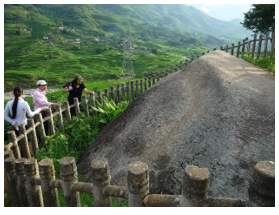
The Area of Old Carved Stones in Sa Pa
The area of old carved stones in Sa Pa lies mainly in the Muong Hoa Valley, where there are settlements of ethnic minority people in Sa Pa District, Lao Cai Province. Carved stones here have been discovered since a long time ago. In 1925, a French scholar coming here discovered more than 30 pieces of stone that had been carved with various images, scattered along the Hoa Spring bank. Later, other scientists have come here to study the carved pieces of stone. Until now, researchers have discovered more than 200 pieces of stone carved with different images, among them are the big ones which have complicated designs.
The most common patterns are images of mountains, hills and fields. In some pieces of stone, we can find images of houses, following the pattern of house on stilts with the form of boat, with curved roof, reminding the image of houses on the Dong Son bronze drums.
Particularly, a number of researchers have raised the hypothesis of traces of 3 kinds of writing system, following the pattern of pictorial writing with straight and curved lines. There are writing systems almost similar to the writing systems found on amulets of Tay ethnic group and Dao ethnic group, but they are not Tay characters. The discovery of the 3 above kinds of writing system on carved pieces of stone makes more complicated the determination of the author of those works.
Maybe those authors belong to many different ethnic minorities and have achieved their works in different times.
There are opinions underlining that those pieces of stone have been carved by the old Viet people, or ethnic groups near to the old Viet people. At present, there remain a number of legends about the "Father piece" and "Mother piece" of stone related to inhabitants of the areas lying at the mountain foot coming here to find new settlements. However, the problem of determination of the real authors of those works is still to be solved.
1. Scientists discovered a number of old carved stones in Sa Pa, which dated back to Dong Son Bronze Age. _____
2. Hundreds of stone pieces have been found with various images, some of which have big, complex patterns. _____
3. The most common topic for the patterns is nature. _____
4. Images of stilt houses on these pieces of stone were the same as those on the Dong Son bronze drums. _____
5. The three kinds of writing system on the carved pieces of stone might share the similar pattern of pictorial writing with straight and curved lines. _____
6. The writing systems on the old carved stones in Sa Pa came from those of Tay and Dao ethnic groups, but they are not Tay characters. _____
7. Tay ethnic group and Dao ethnic group have their own writing systems. _____
8. It is thought that the authors of the ancient carved stones came from many different ethnic minorities, and did them in different times. _____
9. The "Father piece" and "Mother piece" of stone are the biggest ones. _____
10. The early Viet inhabitants of the areas lying at the mountain foot came to Sa Pa to set the "Father piece" and "Mother piece" of stone as their new settlements. _____
III. Read the passage about the Complex of Yen Tu Monuments and Landscape, and then answer the questions.
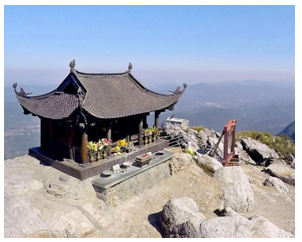
The Complex of Yen Tu Monuments and Landscape
The Complex of Yen Tu Monuments and Landscape is located on the Dong Trieu Range, at the intersection of two provinces: Quang Ninh and Bac Giang. Relics on and excavated under the ground in the Complex of Yen Tu Monuments and Landscape have proved a long history of cultural exchanges in the country. The heritage site, with dozens of pagodas, towers and small temples, and thousands of antiquities - especially old books, preserves spiritual values of Truc Lam Zen Buddhism and the cultural traces of the Dai Viet civilization. The values of Truc Lam Zen Buddhism and Dai Viet culture have been kept throughout the history of Viet Nam, promoted to other countries in the world by generations of Zen masters and will be retained in the future.
Truc Lam is a pure Vietnamese Zen Buddhism which focuses on inner feelings but at the same time enters into life with a forgiveness approach. True Lam aims to connect religion to life in a positive way and builds a close link to true patriotism. King Tran Nhan Tong, the founder of Truc Lam, was the one who collected a lot of older books to guide Buddhists and followers of Truc Lam Zen Buddhism on how to practise their religion and become good people.
Yen Tu is thought of as a natural ecological museum due to its rich bio-diversity. The natural landscape of this place met the requirements of a Buddhism center, which was why it was chosen by Vietnamese Buddhism followers as a place to come and build small temples covered with grass, to practice their religion.
1. What has proved that Yen Tu has a long history of cultural exchanges in the country?
___________________________________________________________________________________
___________________________________________________________________________________
2. What attractions can visitors see at Yen Tu?
___________________________________________________________________________________
___________________________________________________________________________________
3. What does the heritage site preserve?
___________________________________________________________________________________
___________________________________________________________________________________
4. What does Truc Lam Zen Buddhism aim to do?
___________________________________________________________________________________
___________________________________________________________________________________
5. What did King Tran Nhan Tong do for followers of Truc Lam Zen Buddhism?
___________________________________________________________________________________
___________________________________________________________________________________
6. Why was Yen Tu chosen a Buddhism center?
___________________________________________________________________________________
___________________________________________________________________________________
IV. Read the text, and then do the tasks that follow.
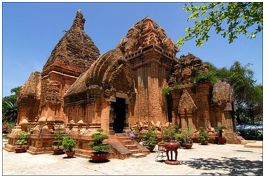
Hidden away in the tropical forest near the port city of Da Nang and the very popular World Heritage town of Hoi An is the Champa civilization’s sacred valley of My Son, or “Beautiful Mountain”. I joined the full day package tour from Hoi An, which was quite very convenient as it included all transportation, ticket fee, lunch and guide. I arrived in My Son around 10 o’clock. After walking for a while, I found the complex of tourist facilities, and one of them is the performance hall. Our guide insisted us keeping going into the forest. Within few minutes, I started to see the complex of ancient Hindu temples made from brick.
At first, the dilapidated state of the complex was quite shocking, and almost nothing was left to see. I decided to discover the site by myself, and I started to be impressed by the amazing quality of brick carving details. The image of Hinduism guardians and angels are truly beautiful and reminded me about Angkor in Cambodia. For me, My Son is the great evidence of how Southern Indian art expanded to Southeast Asia since ancient Cham people came from Java where Indian art flourished, and later expand to modem day Viet Nam and later Cambodia and Thailand. The construction method of My Son is also very unique: Cham people built a whole block of bricks then burned them to make the whole brick block very solid and strong, then chiseled into the temple. I walked around the complex many times to enjoy its intricate motifs until the guide informed that there are more complex to see.
I went to see another complex, this one is located on the hill and recently partial rebuilt by a group of Italian archaeologists, and they are planning to rebuild more, which is a very good news for My Son preservation. The rebuilt complex is very lovely and illustrates the original layout very well even though the new brick really contrasts with the old ones. After that, the guide took me back to the bus and back to Hoi An, it was exactly 3 hours inside My Son. Despite the bad state of preservation, I really enjoyed my visit to My Son, the place has exceeded my expectation and even small complex can clearly show its value as a bridge of cultural exchange between India - Java and mainland Southeast Asia.
Task 1. Answer the following questions.
1. Why was the writer’s tour from Hoi An to My Son very convenient?
___________________________________________________________________________________
___________________________________________________________________________________
2. What was his first impression of My Son? Why?
___________________________________________________________________________________
___________________________________________________________________________________
3. What first made him change his opinion about My Son?
___________________________________________________________________________________
___________________________________________________________________________________
4. Which feature does he find unique about My Son?
___________________________________________________________________________________
___________________________________________________________________________________
5. Why is the writer optimistic about the preservation of My Son in the near future?
___________________________________________________________________________________
___________________________________________________________________________________
6. Why did he enjoy his visit to My Son?
___________________________________________________________________________________
___________________________________________________________________________________
Task 2. Match the underlined words in the text with the definitions.
|
1. sacred |
________ |
A. a person that protects something |
|
2. dilapidated |
________ |
B. a connection between two different things |
|
3. guardian |
________ |
C. a person who studies ancient civilizations, based on objects or part of buildings that are found in the ground |
|
4. chiseled |
________ |
D. having a special religious meaning |
|
5. archeologist |
________ |
E. cut or carved to shape wood or stone |
|
6. bridge |
________ |
F. old and in very bad condition |
V. Read the text and do the tasks that follow.
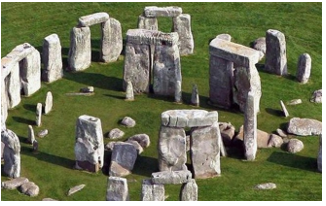
Stonehenge, in the south of England, is an ancient stone circle that was built thousands of years ago at around the same time as the pyramids in Egypt. It has been a UNESCO World Heritage site since 1 ________________ and it is visited by up to 2 ________________ people every year. Come on a guided tour and see this incredible place!
Reviews
‘Our guide told us that the stones around the edge of Stonehenge are called sarsens and the largest ones weighs more than 40 tons and is 3 ________________ feet high. They think the sarsens came from quarries 25 miles away. However, the smaller ones, which are called bluestones and are in the middle of the circle, were from the Presell Hills in Wales. I asked the guide if that was far away and he said it was about 4 ________________ miles away! I can’t imagine how the stones were transported to Stonehenge because they didn’t have any vehicles or machinery.’ Nick 14
‘The guide told us about the remains of a large prehistoric village that was discovered by archeologists last year. It’s less than 5 ________________ miles from Stonehenge and they think it’s where the builders lived when they were constructing the stone circle. He said that they’d found lots of animal bones and pieces of broken pottery. I asked her if they’d had parties there and she thought that was exactly what had happened.’ Cara, 14
‘Stonehenge was a place where the summer solstice, which is the longest day of the year in the Northern Hemisphere, was celebrated. The guide told us that people still come today to celebrate it. they meet very early in the morning and watch the sun rise over the stones. He said it was the most beautiful thing in the world. He asked me if I’d ever seen it. I haven’t, but I’d really like to see it next June 6 ________________.’ Jane, 15
Task 1. Complete the text with the numbers below.
|
24 |
200 |
1986 |
20th |
a million |
two |
Task 2. Read the text, and mark the sentences true (T) or false (F).
1. The pyramids in Egypt are older than Stonehenge. __________
2. Stonehenge was built by UNESCO. __________
3. Different types of stones were used by the builders. __________
4. Some of the stones were carried a great distance. __________
5. Experts have known about the village near Stonehenge for years. __________
6. They believe that the builders who lived there used to have parties. __________
7. Celebrating the summer solstice at Stonehenge is an old tradition. __________
8. Jane went to Stonehenge last June.
VI. Read the article about the Moai, and do the tasks that follow.
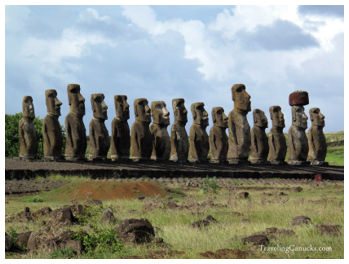
THE MYSTERIOUS MOAI
1 ___________________________________________
The Moai are beautiful stone statues that you can see on the Chilean island of Rapa Nui (Easter Island), in the Pacific Ocean. There are 887 statues, and we know that the first ones were made about 1,00 years ago. However, we don’t know very much about the people who made them, or the reasons why they made them. The stones are a beautiful mystery.
2 ___________________________________________
The Moai are statues of men with very large heads, and smaller bodies and arms. Only one has legs and feet.
3 ___________________________________________
We know that people used hand tools to make the stones because archeologists have found examples of many old tools all over the island. They believed it must have taken about a year to make each statue, with five or six people working on each one.
4 ___________________________________________
This is a more difficult question! Some of the statues are huge, and people can’t have carried them using just their hands. The largest stones are nearly ten metres long, and weigh about 18,000 kilograms. Professor Carla Lopez says, ‘The people must have had some way of moving these stones. Some archeologists think they might have pulled the stones across the island using ropes. But the stones were so heavy, it must have taken between180 and 250 men to pull each one.’
5 ___________________________________________
We don’t know. Most people believe that the statues represent people who had died. However, according to Professor Lopez, ‘We can’t explain why the ancient islanders put so much work into creating these statues, and why so many of the statues are looking away from the ocean. Perhaps the artists believed they were looking towards the villages on the island, to protect them.
6 ___________________________________________
Today Easter Island is a World Heritage site. Thousands of visitors come to study and admire the statues every year. Most people just take photos, but there have been some problems. In 2008, a tourist tried to take a piece of a statue’s ear home as a souvenir. He had to pay $17,000, and he couldn’t go back to the island for three years.
Task 1. Complete the headings with the questions below.
A. How did people make the Moai?
B. How did people move the Moai?
E. What do the Moai look like?
F. Why did people make the Moai?
Task 2. Read the article again. Are the sentences true (T) or false (F)?
1. There are 887 statues. __________
2. There aren’t any statues of women. __________
3. The tools that people used to make the statues have all disappeared. __________
4. It took one man a year to make each statue. __________
5. Some experts believe that people carried the statues by hand. __________
6. Most of the statues look out towards the sea. __________
7. The island is a popular tourist destination. __________
Task 3. Answer the questions.
1. How do archeologists know what the ancient islanders used to make the statues?
__________________________________________________________________________________
2. Why is it possible that people carried the stones?
__________________________________________________________________________________
3. What might the statues protect, according to one expert?
__________________________________________________________________________________
4. How did one man damage a statue?
__________________________________________________________________________________
VII. Read the text, and do the tasks that follow.
The Seven Wonders of the World?
If you read the online editions of newspapers and magazines, you’ll know that internet publications frequently compile top lists ‘The 10 funniest films this year’ or ‘The 20 best sports cars ever’ are just a couple of examples that can be found. However, list writing is not a modem phenomenon. The Ancient Greeks started the fashion with a list that has remained popular for centuries: the Seven Wonders of the World. The Hanging Gardens of Babylon, the statue of Zeus, Artemis sanctuary, the Mausoleum of King Mausolos, the Colossus of Rhodes, the Lighthouse of Alexandria and the Great Pyramid of Giza were all proclaimed to be the best constructions in the world by Greek scholars. But what criteria did they use to decide what was a wonder and what wasn’t?
In the first place, the Greeks didn’t use the word ‘wonders’, but talked about ‘things to be seen’. As the seven monuments were all situated around the Mediterranean Sea, the list was a kind of guide for Greek tourists, possibly the world’s first tourists. Furthermore, it wasn’t impartial, as five of the wonders were built by the Greeks themselves and the list is really a celebration of Greek building techniques. Although the Greeks wouldn’t have known about them, other monuments such as the Great Wall of China or the Mayan Temples in Guatemala existed at the time, and would have been contenders for a place on the list. Not surprisingly then, a lot of other lists have been made throughout history as mankind has continued to create spectacular constructions all over the world.
The most recent example took place in 2007 when an organization called the New7Wonders Foundation set up an internet poll to compile a new list. However, the organizers started badly by not including the only ancient wonder still in existence, the 4500-year-old Great Pyramid. This omission immediately met with worldwide disapproval. It was considered a serious error to exclude a construction of such historical importance. The organizers quickly tried to correct their mistake by giving the pyramid special status. However, further controversy arose when it was discovered that multiple votes could be made by participants. Some countries quickly organized massive campaigns to get their monuments voted for. They sent thousands of text messages to their citizens encouraging them to take part in the poll as often as they wanted. When the results were finally announced at a spectacular ceremony in Lisbon, some observers felt that the event had been turned into a giant publicity stunt for tourism. But was it really so different from the idea behind the Ancient Greeks’ list?
Thanks to the internet, campaigns to categorize monuments, historical artefacts and places of natural beauty will continue. And although such activities are often seen as just entertainment, they do raise our awareness of the need to protect and preserve monuments. However, if people really want to do something to protect our heritage, they need to contact organizations such as UNESCO (The United Nations Educational, Scientific and Cultural Organization). They take the job of looking after the world’s famous monuments very seriously.
Task 1. Decide if the sentences are true (T) or false (F).
1. The list written by the Ancient Greeks were quickly forgotten. ___________
2. The Ancient Greeks used the list to recommend great places to visit. ___________
3. The Mayan Temples weren’t built in time to be included in the original Seven Wonders of the World.
___________
4. The monuments and buildings on the new list were announced in Portugal. ___________
5. The internet will encourage the making of more lists in the future. ___________
Task 2. Read the text again, then choose the best answers.
1. The making of top lists ___________.
A. started with the internet
B. has been popular for years
C. has only happened recently
D. is only done by Greek historians
2. The original Seven Wonders of the World ___________.
A. were in Greece
B. included constructions in China and Guatemala
C. had all been built by Greeks
D. were chosen by Greek experts
3. The Greeks wrote the original list ___________.
A. to express admiration for their own culture
B. as part of the world’s first tourist guide
C. as a guide for builders
D. as a response to lists in other countries
4. The New7Wonders Foundation annoyed people because they ___________.
A. only allow people to vote once
B. organized a publicity stunt in Lisbon
C. didn’t include the Great Pyramid in their list
D. sent text messages asking people to vote
5. The list made by the New7Wonders Foundation ___________.
A. was compiled by experts
B. showed the votes for the best ancient wonder
C. only showed the results of voting in Lisbon
D. recorded votes by people using modem technology
6. UNESCO is an example of an organization that ___________.
A. organizes internet campaigns to complete popularity lists
B. works to protect places of cultural interests
C. specializes in entertainment
D. builds interesting monuments
Task 3. Match the words in bold in the text with these definitions.
1. A study in which people are asked for their opinions about something ________________
2. People that compete with other people to try and win something ________________
3. Made known publicly ________________
4. Traditions, language, and customs that exist from the past and have historical importance for a country ________________
5. To divide people or things into groups ________________
6. A lot of discussion and disagreement about something ________________
7. A feeling that something is bad or wrong ________________
8. To collect information from different places and arrange it in a list, report, etc. ________________
9. Something that has not been included ________________
10. A place where people are protected from harm or danger ________________
11. Not supporting one person or group, but supporting both sides ________________
12. An action that is done to get attention ________________
E. Speaking
• Everyday English
I. Choose the correct response. Then practise the short exchanges in pairs.
|
1. A: Why don’t we visit Trang An Scenic Landscape Complex? |
B: a/ Good. We can enjoy many monuments. b/ Great. It’s ‘Ha Long Bay on Land’. |
|
2. A: Why is the Citadel of the Ho Dynasty unique? |
B: a/ Because the Citadel became empty a long time ago. b/ Because it’s the only stone citadel in Southeast Asia. |
|
3. A: Shall we give a presentation about Taj Mahal? |
B: a/ Right. It’s a World Heritage Site. b/ Not really. It’s a long distance from us. |
|
4. A: Why do so many people want to explore Son Doong Cave? |
B: a/ It belongs to a national park. b/ It’s the largest grotto in the world. |
|
5. A: Why is the Japanese Bridge in Hoi An very well-known? |
B: a/ You can admire the original architecture. b/ It requires repairing and restoration. |
|
6. A: How about visiting the Thang Long Imperial Citadel when we stay there? |
B: a/ Good. There are many souvenirs to buy. b/ Yes. I’d like to see the stone dragons. |
|
7. A: What’s the icon of Ha Long Bay? |
B: a/ It’s Fighting Cock Island. b/ It’s famous for thousands of rocks. |
|
8. A: Let’s go to Hue Imperial Citadel. |
B: a/ Great. We can see the royal tombs there. b/ We can learn its history and traditions. |
|
9. A: Have you ever visited Hoi An Ancient Town? |
B: a/ Yes. We came to some ancient homes. b/ Shall we go to My Son Sanctuary then? |
|
10. A: Which is a natural wonder of the world between the USA and Canada? |
B: a/ It’s Niagara Falls. b/ You can enjoy many beautiful landscapes. |
• Preserving cultural heritage
..........................................
..........................................
..........................................
Xem thêm Bài tập Tiếng anh lớp 11 Global Success theo Unit hay, chi tiết khác:
Bài tập Unit 5: Global warming
Bài tập Unit 6: Preserving our heritage
Bài tập Unit 7: Education options for school-leavers
Bài tập Unit 8: Becoming independent
Bài tập Unit 10: The ecosystem